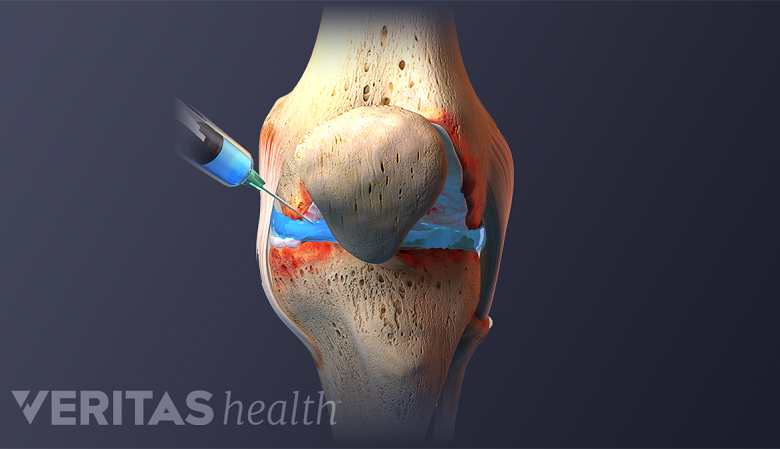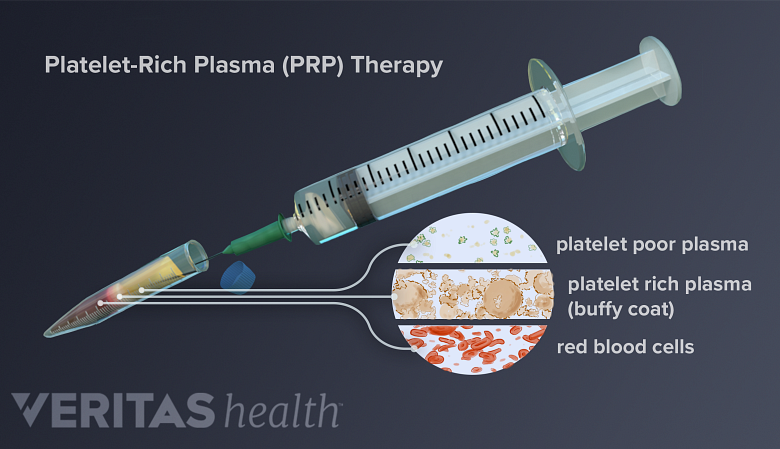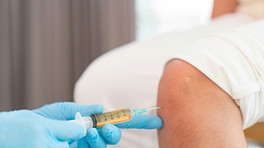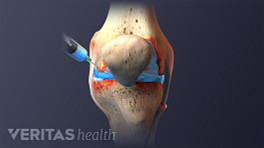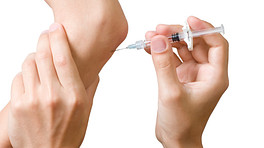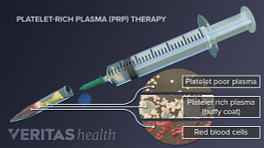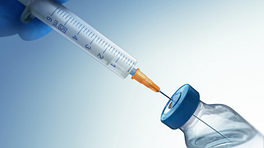Knee pain is a problem for many active people, from professional athletes to weekend warriors. In certain cases, doctors may recommend a therapeutic injection to relieve knee pain.
Therapeutic injection options include cortisone, hyaluronic acid, platelet rich plasma (PRP), prolotherapy, and stem cells. This page discusses these injections and what knee conditions they are used to treat.
See Regenerative Medicine for Sports Injuries
Cortisone Injections
Cortisone knee injections quickly reduce inflammation and offer temporary relief from pain, swelling, and stiffness.
Tissue damage and joint friction in the knee can cause inflammation, which can lead to knee pain, swelling, stiffness, and warmth. Cortisone injections quickly reduce inflammation and offer temporary relief from knee pain and other symptoms.
Read more about Cortisone Injections (Steroid Injections) on Arthritis-health.com
What are cortisone injections used for?
Cortisone injections are most commonly used for:
- Meniscus tears
- Knee ligament tears
- Knee osteoarthritis
- Patellar tendonitis (jumper’s knee) and other knee tendinopathies
- Knee bursitis
- IT band syndrome (less common)
Temporary pain relief may allow a person to engage in a physical therapy intervention or other nonsurgical treatments. Some experts raise concerns that cortisone may cause long term joint tissue damage 1 Nuelle CW, Cook CR, Stoker AM, Cook JL, Sherman SL. In Vivo Toxicity of Local Anesthetics and Corticosteroids on Supraspinatus Tenocyte Cell Viability and Metabolism. Iowa Orthop J. 2018;38:107-112. , 2 Sherman SL, James C, Stoker AM, et al. In Vivo Toxicity of Local Anesthetics and Corticosteroids on Chondrocyte and Synoviocyte Viability and Metabolism. Cartilage. 2015;6(2):106-12. , 3 Piper SL, Kramer JD, Kim HT, Feeley BT. Effects of local anesthetics on articular cartilage. Am J Sports Med. 2011;39(10):2245-53. —particularly if multiple injections are done at the same joint.
Read more about What to Know Before Getting a Cortisone Injection on Arthritis-health.com
Patients who get cortisone injections are advised to progress no more than 10% per week into their previous exercise routine as too much, too fast, or for too long will affect your health and rehabilitation.
Hyaluronic Acid Injections (Viscosupplementation)
The goal of a hyaluronic acid injection is to temporarily lubricate and change the abnormal synovial environment of the knee joint, thereby decreasing knee pain and inflammation and improving knee function.
Read more about the Viscosupplementation Procedure on Arthritis-health.com
What are hyaluronic acid injections used for?
These injections reduce the joint friction and inflammation associated with knee osteoarthritis.
Read more about Viscosupplementation for Knee Osteoarthritis on Arthritis-health.com
Generally, hyaluronic acid injections are slower to take effect than cortisone injections; however, the positive effects may last longer. Hyaluronic injections are sometimes called viscosupplementation injections.
Platelet Rich Plasma Injections (PRP Injections)
PRP uses the patient's blood to repair damaged tissues like cartilage, tendons, ligaments, and muscles.
Platelet-rich plasma therapy attempts to take advantage of the blood's natural healing properties to repair damaged tissue. PRP is concentrated from a sample of the patient's own blood.
See PRP Therapy for Chronic Tendon Injuries
What are PRP injections used for?
PRP has been used to treat many knee conditions, including but not limited to:
- Meniscus tears
- Knee ligament tears
- Knee osteoarthritis
- Patellar tendonitis and other knee tendinopathies
See Platelet-Rich Plasma Injection Procedure
Treatment of meniscus tears is one of the most common uses of PRP injections. 4 Zhang JY, Fabricant PD, Ishmael CR, Wang JC, Petrigliano FA, Jones KJ. Utilization of Platelet-Rich Plasma for Musculoskeletal Injuries: An Analysis of Current Treatment Trends in the United States. Orthop J Sports Med. 2016;4(12):2325967116676241.
Prolotherapy
Prolotherapy temporarily increases inflammation. Limited research suggests that the additional inflammation may stimulate natural tissue repair in the body.
Unlike the other injections described on this page, prolotherapy is not a traditional, single injection treatment. During treatment, a physician repeatedly injects an irritant, such as a dextrose solution, into the knee joint and surrounding tissues. Approximately 15 or 20 injections will be made during one treatment session.
What is prolotherapy used for?
This non-traditional treatment is used to treat many knee conditions, including
5
Reeves KD, Sit RW, Rabago DP. Dextrose Prolotherapy: A Narrative Review of Basic Science, Clinical Research, and Best Treatment Recommendations. Phys Med Rehabil Clin N Am. 2016;27(4):783-823.
:
- Meniscus tears
- Knee ligament tears
- Knee osteoarthritis
- Patellar tendonitis and other knee tendinopathies
- Osgood-Schlatter disease
Prolotherapy is not recommended for people who have inflammatory arthritis, such as rheumatoid arthritis.
Stem Cell Injections
When injected into to an injured knee, stem cells might replace damaged tissue cells; suppress inflammation; slow down tissue degeneration; and/or decrease knee pain.
See Stem Cell Therapy for Sports Injuries
What are stem cells injections used for?
Stem cell injections may be used to treat:
- Meniscus tears
- Knee ligament tears
- Knee osteoarthritis
- Patellar tendonitis and other knee tendinopathies
The stem cells used in these injections are usually collected from the patient’s fat tissue, blood, or bone marrow.
How Effective Are Therapeutic Knee Injections?
Not everyone who receives a therapeutic injection will experience a reduction in knee pain. Success rates will vary depending on the type of injection and the condition being treated.
PRP injections, stem cell injections, and prolotherapy are not considered standard practice. Many clinical research studies suggest that regenerative treatments are effective. However, these clinical research studies vary in quality. Well-designed, randomized, controlled studies are in progress and may help standardize regenerative medicine treatment processes.
Regenerative medicine treatments are widely available. They are offered by physicians with varying credentials. Read more about choosing regenerative medicine treatments, including a list of questions to ask a physician.
- 1 Nuelle CW, Cook CR, Stoker AM, Cook JL, Sherman SL. In Vivo Toxicity of Local Anesthetics and Corticosteroids on Supraspinatus Tenocyte Cell Viability and Metabolism. Iowa Orthop J. 2018;38:107-112.
- 2 Sherman SL, James C, Stoker AM, et al. In Vivo Toxicity of Local Anesthetics and Corticosteroids on Chondrocyte and Synoviocyte Viability and Metabolism. Cartilage. 2015;6(2):106-12.
- 3 Piper SL, Kramer JD, Kim HT, Feeley BT. Effects of local anesthetics on articular cartilage. Am J Sports Med. 2011;39(10):2245-53.
- 4 Zhang JY, Fabricant PD, Ishmael CR, Wang JC, Petrigliano FA, Jones KJ. Utilization of Platelet-Rich Plasma for Musculoskeletal Injuries: An Analysis of Current Treatment Trends in the United States. Orthop J Sports Med. 2016;4(12):2325967116676241.
- 5 Reeves KD, Sit RW, Rabago DP. Dextrose Prolotherapy: A Narrative Review of Basic Science, Clinical Research, and Best Treatment Recommendations. Phys Med Rehabil Clin N Am. 2016;27(4):783-823.
